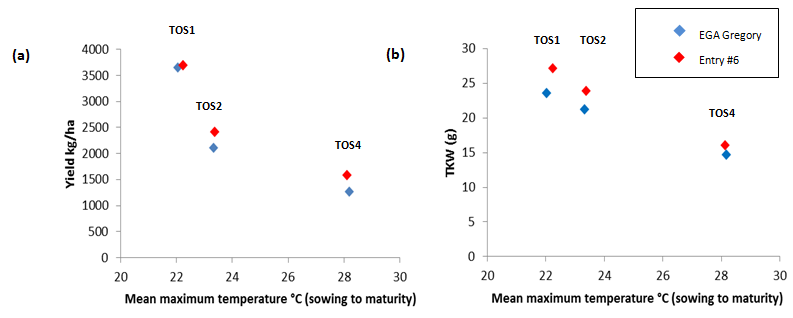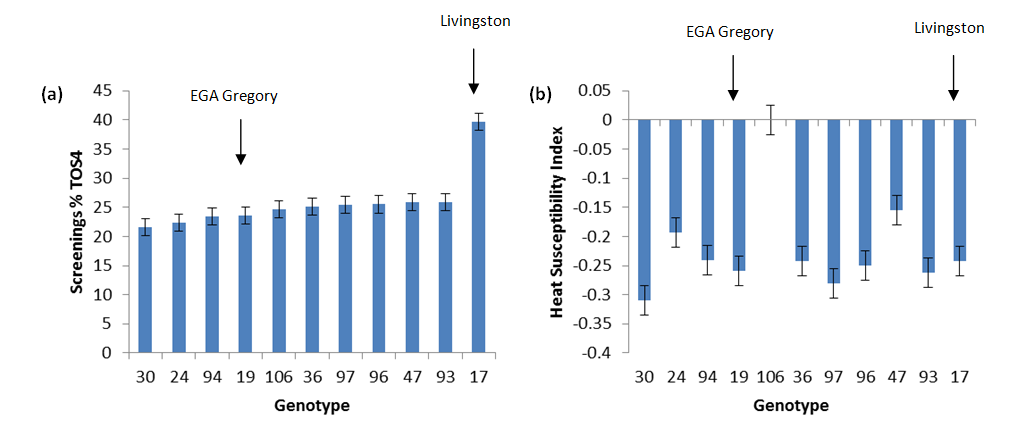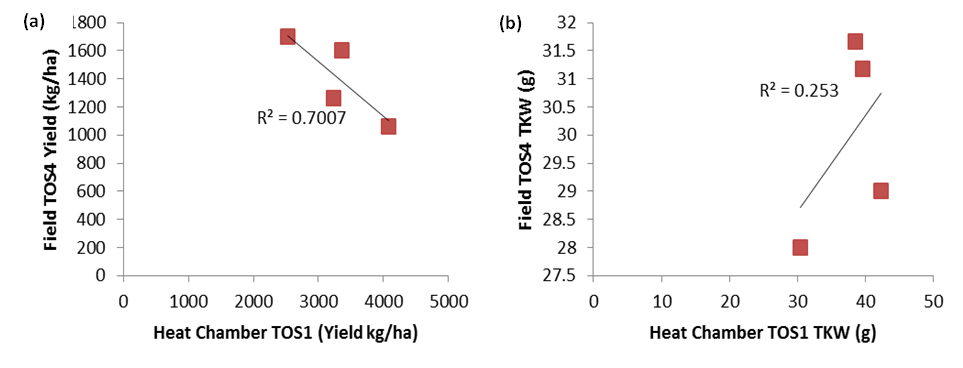Heat tolerance wheat varietal differences and improved phenotyping methods
Author: Rebecca Thistlethwaite, Richard Trethowan & Daniel Tan, IA Watson Grains Research Centre, The University of Sydney | Date: 28 Feb 2017
Take home messages
- Increasing temperatures will make high yielding wheat production difficult in future years.
- High temperatures and/or ‘heat shock’ experienced during critical growth stages of anthesis and grain filling is extremely detrimental to a wheat plant.
- There is a great need to identify genetic diversity for high temperature heat tolerance and better understand the combination of traits associated with a heat tolerant wheat type.
Rationale behind research
High temperature stress continues to cause damage to wheat (Tritium aestival) crops across the north western grain production belt of New South Wales, Australia. This is particularly crippling when heat stress exceeding 35°C is experienced during the reproductive stages of pollen formation and anthesis causing significant yield loss.
In a GRDC funded initiative to reduce the impact of heat stress on grain production, 120 wheat genotypes were selected for evaluation across four growing seasons at the I.A. Watson Grain Research Centre, Narrabri. Of this, a smaller subset of twenty was trialled across multiple years. Most of the materials were sourced from the international breeding centres at ICARDA and CIMMYT and were developed for areas where extreme temperatures for short durations during anthesis and grain filling are common, and were selected based on reports of putative tolerance to high-temperature. Days to anthesis, plant height, grain weight, yield and key physiological responses were assessed. A heat susceptibility index (HSI) was used to compare genotypes based on their relative susceptibility to high temperature.
Equally important as developing germplasm with heat tolerance was the development of reliable, high-throughput phenotyping methods for identifying these lines. To assess the validity of screening for heat tolerance using delayed sowing, portable field heat chambers designed to cover yield plots were placed on selected optimally sown materials at anthesis and maintained at 4°C above ambient temperature for three days. An additional chamber maintained at ambient temperature was also used for comparison.
What are we doing to ensure Northern Region wheat producers can combat increasing temperatures in the field?
- Obtaining international sources of germplasm with putative heat tolerance via detailed trait based selection.
- Performing multi-year trials to assess and ensure trait stability.
- Identifying the heat tolerance potential of Australian cultivars for current production and future breeding purposes.
- Better understanding the combination of traits and phenological/physiological requirements for a genotype to perform under high temperature stress.
Various results from trials conducted during 2012-2014
Using delayed sowing as a mechanism for inducing heat stress, 120 wheat genotypes were screened for heat tolerance between 2012 and 2014. These lines were screened over multiple tears to give plant breeders the ability to assess overall trait stability.
Across all germplasm and times of sowing from 2012 to 2014, a regression analysis demonstrated that (regardless of genotype and only taking into consideration consecutive times of sowing) for every 1°C rise in mean maximum temperature there is 281 kg/ha yield loss. This demonstrates that heat stress causes significant yield loss in current commercial varieties, and represents an opportunity for improved genetics to play a significant role in reducing the impact through breeding.
Indeed, a number of lines with enhanced heat tolerance were identified from the germplasm tested. One such example with genetic potential is a CIMMYT line (Entry # 6, CIMMYT derived 80:ZWW10) presented in Figure 1.1. Livingston and EGA Gregory were the best performing Australian commercial cultivars of those tested. They showed a considerable amount of promising heat tolerance (Figure 1.1) with regards to yield under high temperature, however genotypes sourced from Mexico and India were continuously the best performers based on other desirable traits, such as thousand grain weight and screening %.
Figure 1. Relationships between mean maximum temperature °C and (a) yield kg/ha and (b) TKW (g) for EGA Gregory (commercial heat tolerant benchmark) and Entry #6 (CIMMYT derived 80:ZWW10) 2012 -2014.
Figure 2 highlights the best performing genotypes in the August (TOS4) planting of 2014 based on the amount of screenings (grain <2mm) collected from the harvested sample. A heat susceptibilty index, which is a function of the on-time and late sown indiviudal genotype yields vs. average on-time and late sown yields for that particular trial was calculated for all genotypes. A low HSI value represents a high level of heat tolerance. This figure demonstrates that there is a range of diverse germplasm with heat tolerance greater than industry standards, representing an opportunity for genetic intervention through a targeted pre-breeding program.

Figure 2. Best performing genotypes in 2014 only based on (a) screenings % and their corresponding (b) heat susceptibility index (HSI) presented for comparison. Commercial cultivars include Entry #17 Livingston and Entry #19 EGA Gregory Note: Low HSI = high heat tolerance.
Figure 3 shows significant yield loss between sowing and maturity as a result of later planting. A decrease of 457 kg/ha for every 1°C rise in mean maximum temperature was observed. A similar result was also observed for TKW with the greatest decrease of approximately 2g between sowing and maturity. These results were consistent from 2012 to 2015, 2014 data is presented below.

Figure 3.Relationships between mean maximum temperature °C and (a) yield kg/ha and (b) TKW (g) for 20 common genotypes, 2014 data presented only.
How are we assessing trait stability and the mechanisms for heat tolerance?
- Assessing large amounts of genetic material across four consecutive sowing dates (May, June, July and August).
- Collecting phenological data on many traits associated with optimal functionality to ensure high yield.
- Implementing a ‘heat shock’ at flowering to both tolerant and susceptible genotypes using in-field controlled environment chambers.
- Comparing treatment environments of field, glasshouse and in-field controlled environment chambers.
- Linking the phenomics with the genomics using gene mapping techniques.
Various results of in-field controlled chambers and field environments in 2013-2014
While the genotypes assessed ranked similarly to heat stress generated in both the field chamber and by late sowing, the correlation between these methods was not as strong as would be expected. This is due to the yields in heat chambers being largely driven by grain number as a result of high temperatures at anthesis causing pollen sterility and affecting the number of viable florets. Late sowing however resulted in higher grain filling temperatures which influenced both kernel number and kernel weight (Figure 1.4). Importantly, both these heat stress periods occur in the northern region, and mechanisms of tolerance to both periods of stress are critical if germplasm is to be effective at combating high temperatures regardless of its timing. Consequently, both the delayed sowing and heat chamber phenotyping methods are necessary to effectively identify germplasm with heat tolerance to both anthesis and grain-fill heat tolerance mechanisms.

Figure 4. Relationships between field late sowing and heat chambers placed at anthesis in early sowing in the field for (a) yield and (b) thousand kernel weight (TKW) over three years. Data of four varieties tested in all years is presented.
Why does this research matter?
This research is important for wheat producers in the Northern NSW growing region because it demonstrates that:
- Genetic diversity for heat tolerance is present in Australian and International wheat germplasm.
- Repeatable and reliable field based screening methods for heat tolerance in wheat can be developed.
- Multi-year trials are important in fully understanding how a genotype performs over a range of differing seasonal conditions.
- Phenological data collection across multiple sowing dates and seasonal conditions is highly beneficial when assessing trait stability
- It is not just yield that needs to be considered! Other yield components such as the amount of small seed (screenings %), TKW, kernel number and kernel weight are also very important.
- Multiple mechanisms for heat tolerance exist, and need to be phenotyped for separately.
The identification of germplasm with heat tolerance has provided researchers with an opportunity to identify the key genetic and physiological mechanisms for heat tolerance, and subsequently combine these traits in a pre-breeding effort to deliver improved heat tolerance genetics to growers in the northern region. This is a long-term process, but will ultimately provide growers with commercial varieties more adapted to the northern region both for current and, if climate forecast models are correct, into the future climatic conditions.
Acknowledgements
The research undertaken as part of this project is made possible by the significant contributions of growers through both trial cooperation and the support of the GRDC; the authors would like to thank them for their continued support.
Contact details
Ms Rebecca Thistlethwaite
IA Watson Grains Research Centre
Ph: 0403 525 345
Email: Rebecca.thistlethwaite@sydney.edu.au
Professor Richard Trethowan
IA Watson Grains Research Centre
Ph: 02 9351 8860
Email: Richard.trethowan@sydney.edu.au
Varieties displaying this symbol beside them are protected under the Plant Breeders Rights Act 1994.
GRDC Project Code: US00057,
Was this page helpful?
YOUR FEEDBACK
